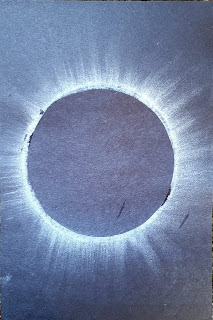On April 8th a solar eclipse is going to occur over North America. The 120-mile-long path of totality will touch 15 U.S. states: Texas, Oklahoma, Arkansas, Missouri, Tennessee, Kentucky, Illinois, Indiana, Ohio, Michigan, Pennsylvania, New York, Vermont, New Hampshire, and Maine.
A solar eclipse occurs when the moon passes between the Earth and the sun, blocking the sun's light and causing a shadow to be cast upon the Earth. For a solar eclipse to occur, the sun, the moon, and the Earth have to be in perfect alignment.
Below are some activities and learning resources to help you prepare your kids for the upcoming solar eclipse.
Solar Eclipse Activities for Kids
Printable Eclipse Activity Pack
My printable Eclipse Activity Pack includes diagrams, reading sheets, vocabulary words, a crossword puzzle, an eclipse journaling sheet, 2 flip books, a cut and paste paper eclipse model, and more! Grab it here: Printable Eclipse Activity Pack.
Solar Eclipse Videos
•Solar Eclipse 101 from National Geographic
•Total Solar Eclipse Timelapse from Celestron
•What is a Solar Eclipse? from NASA Space Place
•Solar Eclipse Facts for Kids from Homeschool Pop
Solar Eclipse Books
•Who HQ: What is a Solar Eclipse by Dana Meachen Rau
•Who Turned Off the Sun by Lisa Combs
•Totality! An Eclipse Guide in Rhyme and Science by Jeffrey Bennett
Websites
Make a Pinhole Viewer
To make a pinhole viewer you will need:
-a piece of cardstock, cut in half, or two small pieces of cardboard
-a thumbtack
Poke a hole in the center of one of the pieces of cardstock using the thumbtack. Make sure the hole is round and smooth. Hold the piece of cardstock with the hole. Position it so that the sun shines directly onto it and through the hole. Position the second piece of cardstock a little way below the first piece of cardstock, so that the sun shines through the hole in the first piece, projecting an image onto the second piece.
Check out this video from SciShow Kids for video instructions: Make an Eclipse Viewer
This video from NASA Goddard has instructions for another type of pinhole viewer: How to Make a Box Pinhole Viewer
Build an Eclipse Model
Try building a model of an eclipse. Follow the instructions on one of the links below or get creative and come up with your own way to make a model.
•Solar Eclipse Model DIY from Generation Genius: this model uses a yard stick, clay balls, toothpicks, and paper clips.
•How to Make a Solar Eclipse Model from BBC Sky at Night Magazine: this model uses a beach ball, a smaller ball, and a lamp or flashlight.
Solar Eclipse Art and Craft Activities
If you're a crafty family, check out the solar eclipse themed art and craft activities below.
•Solar eclipse chalk art
You will need two pieces of black construction paper, a pencil, white chalk, scissors, glue, and something round to trace.
Trace a circle onto both pieces of construction paper using a pencil. We traced an old oat container to make ours.
Cut out one of the circles and set it aside.
Trace the other circle with white chalk.
Use your finger to spread the chalk outward from the circle.
Clean the chalk off your fingers, then glue the cut out black circle in the center of the chalk circle.
•Make an eclipse flip book: try making an eclipse flip book by drawing the progression of an eclipse on small pieces of cardstock. Stack them in order, fasten them together, and then flip through!
If you prefer a printable version, I have a solar eclipse flip book in my printable solar eclipse activity pack, available here: https://www.teacherspayteachers.com/Product/Eclipse-Activity-and-Learning-Pack-11243993
If you enjoyed this post, check out:
Follow me on










Comments
Post a Comment